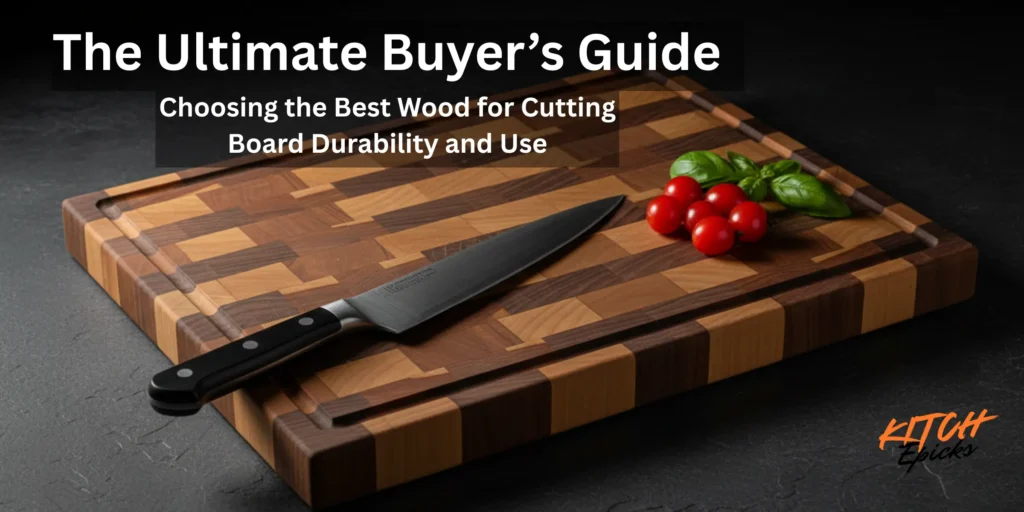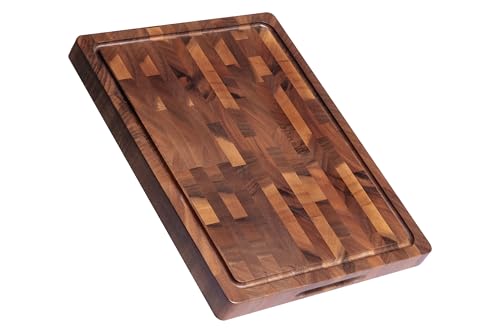Best Wood for Cutting Board choices can make or break your kitchen workflow. A cutting board isn’t just a slab of wood on the counter—it’s one of the most important tools in any cook’s arsenal. The right board protects your knives, provides a safe surface for food preparation, and can last for years with proper care. On the other hand, the wrong board can quickly dull your blades, harbor bacteria, or warp after just a few uses. With so many different options—maple, walnut, cherry, teak, acacia, and more—home cooks and professionals alike often wonder: How do you choose the best wood for a cutting board that balances durability, knife-friendliness, and style?
This guide covers criteria, top wood choices, grain styles, materials to avoid, and care tips, so you can make a confident choice.
Why Choosing the Right Cutting Board Matters
A good cutting board will:
- Protect your knives from premature dulling
- Prevent bacteria from seeping in
- Last for years (even decades) with the right care
According to USDA food safety guidelines, surface material plays a role in reducing bacterial contamination, making wood a smart choice when properly maintained.
Want to explore other smart tools that make cooking healthier and easier? Check out this guide on Smart Kitchen Tools for Healthier Cooking.
Criteria for Selecting the Best Wooden Cutting Board
When evaluating wood types, here are the five main factors that matter:
| Criteria | Why It Matters | Best Choices | Avoid |
|---|---|---|---|
| Toxicity | Must be food-safe; no harmful oils/resins | Trees producing edible fruits/nuts (Maple, Walnut, Cherry, Beech) | Exotic toxic woods |
| Hardness (Janka Scale) | Too hard dulls knives; too soft dents easily | Mid-range (Maple ~1450, Walnut ~1010) | Very hard woods (Acacia ~1750, Mahogany) |
| Porosity (Wood Grain) | Closed grains resist moisture, germs | Maple, Cherry, Walnut | Oak, Ash (open-grained) |
| Sustainability | Eco-friendly sourcing matters | FSC-certified or domestic woods | Non-certified exotic imports |
| Maintenance | Ease of oiling/conditioning | Maple, Walnut, Cherry | Oily/silica-heavy woods like Teak (higher upkeep) |
💡 Pro Tip: Avoid woods that are too hard (like Acacia) or too soft (like Pine). They either dull your knives or fall apart too quickly.
Comparison of Top Wood Choices
Here’s a breakdown of the most popular cutting board woods, ranked by durability, knife-friendliness, and appearance:
| Wood Type | Janka Hardness (lbf) | Benefits | |
|---|---|---|---|
| Walnut (~1,010) | Gentle on knives, beautiful dark finish, hides stains well | Expensive, needs more frequent oiling | |
| Maple (~1,450) | Durable, food-safe, tight grain, industry “gold standard” | Can dull knives slightly faster, stains show | |
| Cherry (~950) | Easy on knives, develops rich patina, low maintenance | Softer—scratches and dents more easily | |
| Teak (~1,155) | Naturally oily, moisture-resistant, low upkeep | Contains silica (hard on blades), pricey, sustainability concerns | |
| Acacia (~1,750) | Budget-friendly, sustainable, durable | Very hard (knife dulling), heavy |
Best All-Around Choice: Maple
Most Elegant Choice: Walnut
Budget-Friendly Pick: Acacia (with caveats)
👉 For quick meals where you don’t want to pull out your heavy board, pairing it with an Air Fryer can save time and cleanup.
Grain Style: End-Grain vs. Edge-Grain
The way wood is cut and joined changes performance dramatically.
- End-Grain (Butcher Block)
- Knife slips between vertical fibers → gentler on blades.
- Self-healing surface (minimizes visible cuts).
- Thicker, heavier, and more durable—but also pricier.
- Edge-Grain
- Fibers run horizontally; knives cut across fibers.
- More affordable and lighter, but shows wear faster.
- A good compromise for everyday home use.
| Grain Style | Pros | Cons | Best For |
|---|---|---|---|
| End-Grain | Knife-friendly, self-healing, long-lasting | Heavy, expensive | Professionals, enthusiasts |
| Edge-Grain | Affordable, lighter, durable enough | More visible cuts, less forgiving on knives | Everyday kitchens |
📌 Thinking about upgrading other gear? See our deep-dive on Skillet vs Frying Pan to pick the right pan for your cooking style.
Materials to Avoid
Some cutting board materials are bad for knives, food safety, or longevity:
- Softwoods (Pine, Cedar, Fir) – too soft, splinter, absorb bacteria.
- Open-Grain Hardwoods (Oak, Ash) – porous, trap moisture.
- Glass & Marble – destroy knife edges instantly.
- Plastic – traps bacteria in scars, can’t be resurfaced.
- Bamboo – eco-friendly but overly hard and not refinishable.
Maintenance & Conditioning Tips
A well-maintained wooden cutting board can last 10+ years. Here’s how:
- Cleaning: Hand wash only with mild soap and warm water. Dry upright.
- Oiling: Apply food-grade mineral oil or fractionated coconut oil monthly.
- Waxing: Use a beeswax + oil blend for waterproofing.
- Avoid: Olive, corn, or sunflower oil (go rancid).
- Natural Sanitizing: Rub with lemon + coarse salt for deodorizing and disinfecting.
💡 Pair your cutting board with smart appliances for easier prep—see our Best Electric Lunch Box 2025 picks for portable, healthy meals.
Final Recommendations
- Best All-Around: Maple (durability + safety).
- Most Elegant: Walnut (gentle on knives, hides stains).
- Lowest Maintenance: Teak (if FSC-certified).
- Budget-Friendly: Acacia (but harder on knives).
With the right wood, proper grain, and simple maintenance, your board becomes an investment piece. Pair it with modern cooking tools like an Air Fryer or a Waffle Maker for the ultimate kitchen upgrade.
Conclusion: Invest in the Right Cutting Board
Choosing the best wooden cutting board isn’t just about style—it’s about safety, durability, and elevating your cooking experience. A well-selected board protects your knives, resists bacteria, and becomes the foundation of every meal you prepare.
- If you want a balanced, professional-grade choice, go with Maple.
- If elegance and knife-friendliness are priorities, Walnut is unbeatable.
- For low-maintenance convenience, Teak is a solid option (as long as it’s sustainably sourced).
- And if you’re on a budget, Acacia can deliver value with a bit of compromise.
No matter which wood you choose, proper care—regular oiling, safe cleaning, and mindful use—ensures your board will last for years to come. A high-quality cutting board is more than a tool: it’s a culinary investment that pays dividends every single day in your kitchen.
So before your next meal prep, consider upgrading to a board that will make chopping, slicing, and dicing easier, safer, and more enjoyable.
👉 Browse the top-rated cutting boards here , and pair your choice with modern tools like an Air Fryer or Waffle Maker to transform your kitchen setup.
Related Reads
- Smart Kitchen Tools for Healthier Cooking
- Hash Brown Patties in the Air Fryer
- Ninja Air Fryer Review 2025
- Best Air Fryer 2025 Reviews
- Best Electric Lunch Box 2025
- Skillet vs Frying Pan
- Best Liege Waffle Maker
❓ Frequently Asked Questions
What is the best wood for cutting boards?
Hard Maple is considered the gold standard for cutting boards thanks to its durability, tight grain, and food-safety. Walnut and Cherry are also excellent choices for being gentle on knives and visually appealing.
Is teak a good wood for cutting boards?
Yes, teak is moisture-resistant and naturally oily, which makes it easy to maintain. However, it contains silica, which can dull knives faster. Make sure to choose sustainably sourced or FSC-certified teak boards.
Which cutting board wood is gentlest on knives?
Walnut and Cherry are the most knife-friendly woods because of their lower hardness ratings, which help keep blades sharper for longer.
What is the difference between end-grain and edge-grain cutting boards?
End-grain boards are made with vertical wood fibers, making them self-healing and very gentle on knives. Edge-grain boards are more affordable but show knife marks faster and are less forgiving on blades.
How do you maintain a wooden cutting board?
Hand wash with mild soap and warm water, dry upright, and apply food-grade mineral oil or fractionated coconut oil once a month. Avoid dishwashers and vegetable oils that can turn rancid.




![Bamboo Cutting Boards for Kitchen [Set of 3] Wood Cutting Board f...](https://m.media-amazon.com/images/I/41l-LAYk+mL.jpg)